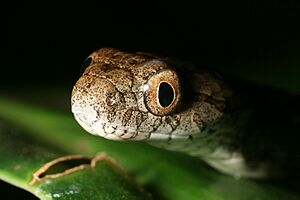Amazon coastal house snake facts for kids
Quick facts for kids Amazon coastal house snake |
|
|---|---|
 |
|
| Conservation status | |
| Scientific classification | |
| Genus: |
Thamnodynastes
|
| Species: |
pallidus
|
| Synonyms | |
|
|
The Amazon coastal house snake, known scientifically as Thamnodynastes pallidus, is a type of snake. It belongs to the family called Colubridae. This snake is only found in South America, meaning it is endemic to that continent.
Contents
About the Amazon Coastal House Snake
Thamnodynastes pallidus is a fascinating snake. It is part of the Colubridae family. This family includes many common snakes around the world. Most snakes in this group are not venomous. They are often found living near people's homes or farms. This is how they get the "house snake" part of their name.
What is a Species?
When we talk about a species, we mean a group of living things that are very similar. They can also have babies together. Thamnodynastes pallidus is one specific species of snake. It has unique features that set it apart from other snakes.
Who Named This Snake?
The famous scientist Carl Linnaeus first described this snake in 1758. He gave it its scientific name. Linnaeus was a very important person in biology. He created the system we use today to name all living things.
Where This Snake Lives
The Amazon coastal house snake lives in many countries across South America. It is found in both coastal areas and parts of the Amazon region. This wide range helps it find different habitats.
Countries Where It's Found
You can find T. pallidus in these South American countries:
This shows that the snake can adapt to different environments. It lives in a large part of the continent.


